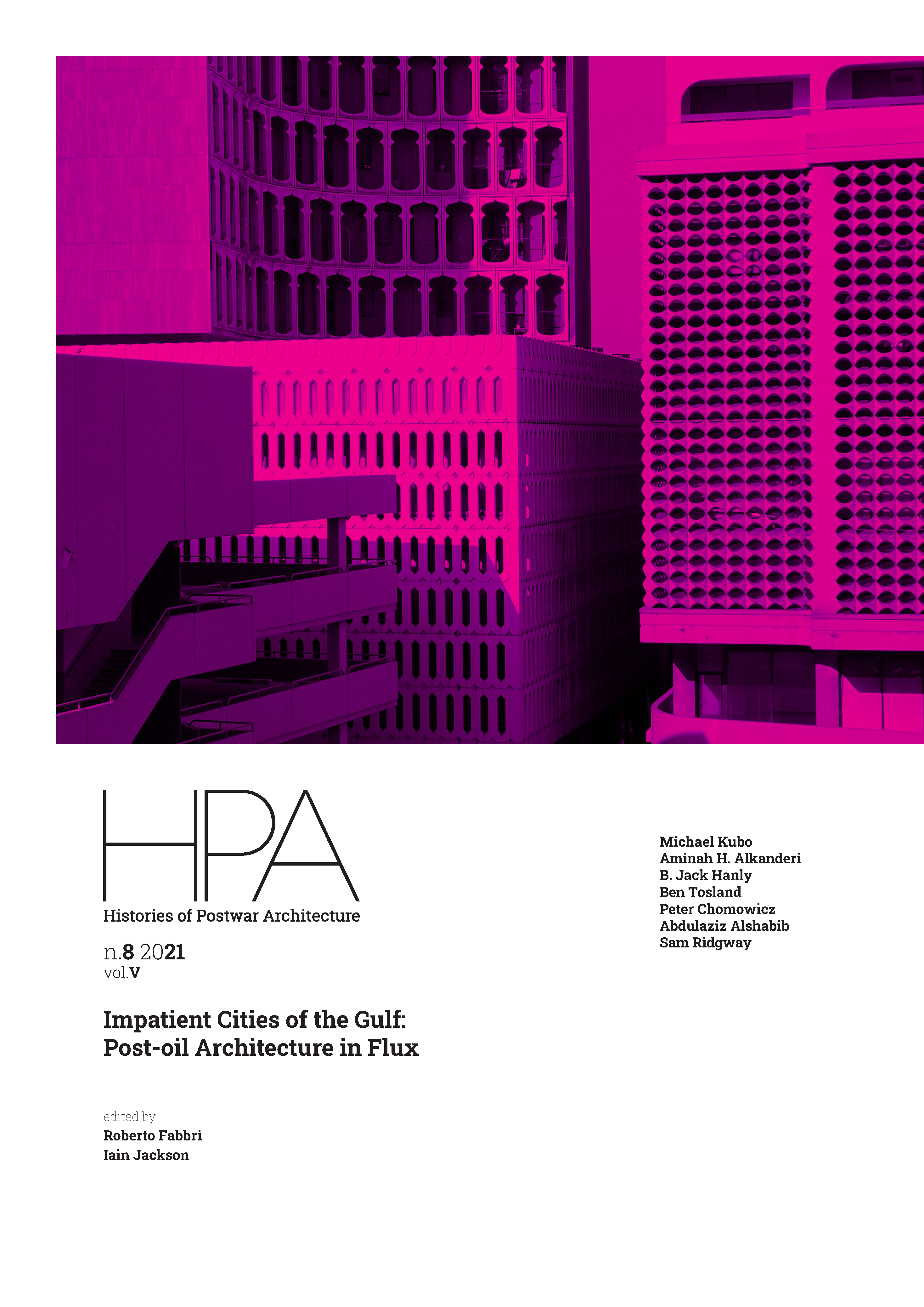Aramco and Al-Malaz Housing Schemes: The Origins of Modern Housing in Saudi Arabia
DOI:
https://doi.org/10.6092/issn.2611-0075/11738Keywords:
Post-oil residential architecture, Saudi housing projects, In-situ and prefabricated housing, Aramco Home Ownership Program, Al-Malaz housing projectAbstract
This paper examines two influential, modern housing schemes outside the oil compounds in Saudi Arabia. The first, Aramco’s Home Ownership Program from the early 1950s, built houses for Saudi oil workers and their families. The second, the Al-Malaz Housing Project, sponsored by the Saudi Government in the late 1950s, produced houses for government employees. These two schemes mark the beginning of the dramatic and widespread overturning of vernacular building traditions in Saudi Arabia. In contrast to the prefabricated lightweight buildings inside the oil compounds these houses were constructed using heavy masonry, mainly locally-made concrete blocks and concrete floor slabs, and they were built in situ. Nevertheless, they are strongly linked to the imported architectural design and construction techniques found inside the compounds.
For Aramco, the need to provide better accommodation for Saudi workers was highlighted by the vastly different conditions for expats and local Saudi workers. Inside the camps, expats lived in modern, imported, prefabricated timber buildings laid out in neat suburbs. Local workers lived outside the fence in ramshackle “Coolie Camps” made up of traditional barastis, tents and other structures put together from salvaged materials. While the Aramco program led to the construction of thousands of houses mainly in the eastern oil-rich regions, Al-Malaz, in the capital of Saudi Arabia, signified mainstream acceptance of modern housing design and construction by the Saudi government. Al Malaz was the first of numerous government-sponsored and developer-led housing schemes using modern, non-traditional designs and heavyweight in-situ, and later prefabricated concrete construction.
Downloads
References
Al-Ghathami, Abdullah. Hekayat Al Hadaathah fi Al-mamlakah Al-Arabiya Al-Saudia [The Story of Modernism in the Saudi Arabia]. Casablanca: The Arab Cultural Centre, 2004.
Al-Naim, Mashary. ‘Identity in Transitional Context: Open-Ended Local Architecture in Saudi Arabia’. International Journal of Architecture Research 2, no. 2 (2008).
Al-Said, Fahad. ‘Territorial Behaviour and the Built Environment: The Case of Arab-Muslim Towns, Saudi Arabia’. PhD diss., University of Glasgow, 1992.
Al-Said, Fahad. ‘The pattern of structural transformation of the Saudi contemporary neighbourhood: The case of Al-Malaz, Riyadh, Saudi Arabia’. The 39th ISoCaRP Congress, 2003.
Anis-ur-Rahmaan, Bushra A. Rahmaan and A. Al-Shaye. ‘Innovation Diffusion in Housing: A Conceptual Probe in Saudi Arabia’. J. King Saud University: Architecture and Planning 2 (1990): 3-21.
Bammes, Donald M. Al-Ayyam Al-Jamilah 6, no. 1 (March 1962).
Candilis Metra Int. Eastern Region Plan, Existing Conditions. Dammam: June 1974.
Choguill, Charles L. ‘A Survey of Saudi Arabian Urban Problems’. J. King Saud University: Architecture and Planning 20, (2008).
Coon, Carleton S., and William A. Eltiste. ‘Operation Bultiste: Promoting Industrial
Development in Saudi Arabia’. In Hands Across Frontiers, eds. Howard M. Teaf Jr. and Peter G. Franck. Ithaca, New York: Cornell University Press, 1955.
Danforth, Loring M. Crossing the Kingdom: Portraits of Saudi Arabia. Oakland, California: University of California Press, 2016.
Eben Saleh, Mohammed. ‘The evolution of planning & urban theory from the perspective of vernacular design: MOMRA initiatives in improving Saudi Arabian neighbourhoods’. Land Use Policy 18, (2001).
Facey, William. Riyadh, the Old City: From its Origins Until the 1950s. London: Immel, 1990.
Fadan, Yousef. ‘The Development of Contemporary Housing in Saudi Arabia (1950– 1983): A Study in Cross-Cultural Influence Under Conditions of Rapid Change’. PhD diss., Massachusetts Institute of Technology, 1983.
Lackner, Helen. A House Built on Sand: A Political Economy of Saudi Arabia. London: Ithaca Press, 1978.
Lebkicher, Roy. Aramco and World Oil. New York: R.F. Moore, 1952.
Lebkicher, Roy. Aramco handbook. Dhahran: Arabian American Oil Company, 1960.
McMurray, Scott. Energy to the World: The Story of Saudi Aramco. Houston: Aramco Services Company, 2011.
Middleton, Deborah. ‘Growth and Expansion in Post-War Urban Design Strategies: C. A. Doxiadis and the First Strategic Plan for Riyadh Saudi Arabia (1968-1972)’. PhD diss., Georgia Institute of Technology, 2009.
Parssinen, Jon, and Kaizir Talib. ‘A Traditional Community and Modernization: Saudi Camp, Dhahran’. JAE 35, no. 3 (1982): 14–17.
Philby, Harry St John Bridger. Arabian Jubilee: An Account of the Reign of Ibn Sa'ud, King of Saudi Arabia. With Plates, Including Portraits. London: Robert Hale, 1952.
Vitalis, Robert. ‘Wallace Stegner's Arabian Discovery: Imperial Blind Spots in a Continental Vision’. Pacific Historical Review 76, no. 3 (2007): 405–37.
Wurster, Catherine. ‘The Social Front of Modern Architecture in the 1930s’. Journal of the Society of Architectural Historians 24, no. 1 (1965): 48-52.
Downloads
Published
How to Cite
Issue
Section
License
Copyright (c) 2022 Abdulaziz Alshabib, Sam Ridgway

This work is licensed under a Creative Commons Attribution 4.0 International License.





